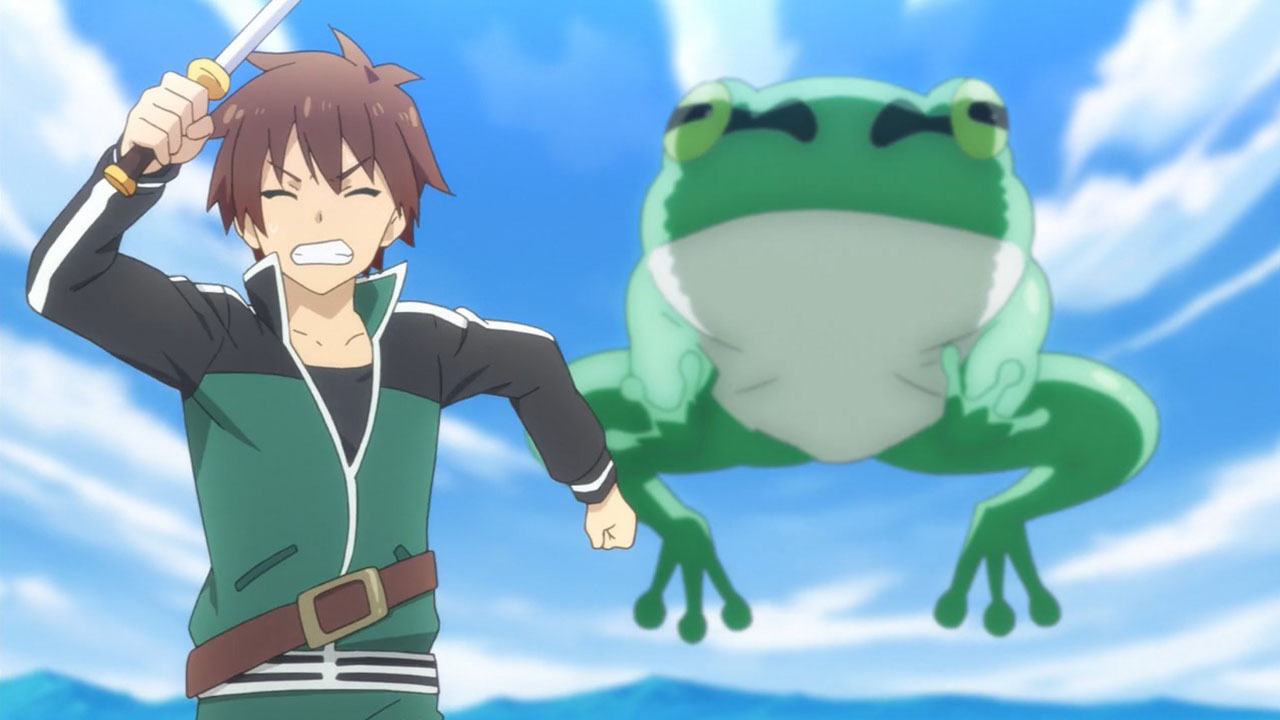Let's Read the 4e Monster Manual 3: Frog

This post is part of a series! Click here to see the others.
Every individual roleplayer has a set of D&D monsters they consider “iconic”, regardless of what the publisher has to say about it. Years ago, I remember one such player saying that to him “giant fucking frogs” were the most iconic D&D monster. It’s not D&D if you don’t fight a huge-ass frog at some point.
By that criterion we can shut the grognards up for good now. Here is the moment when 4e finally becomes D&D.
The Lore
Real-world frogs are usually quite useful creatures. Most species are harmless to humans and eat disease-spreading insects. Some consider them cute and, if nothing else, they can be tasty when properly prepared.
In typical D&D fashion, this book calls such creatures “pests” because they’re not fuzzy wabbits. And then it moves on to focus on monstrous frogs, who are big and aggressive enough to eat people. They live in surface swamps and on underground lakes in “natural” caves or in the shallow Underdark. There are several different species, and the book implies they’re atavistic survivors from the world’s prehistory, like sharks and crocodiles in the real world.
A monstrous frog won’t usually leave its home territory to hunt people, but it will eat anyone foolish enough to wander through that territory. “Beware of Frog” signs are a common sight in villages close to the borders of their habitat. Frog attacks are a potential hazard for PCs traveling through marshy terrain, and the book suggests they could be hired by a wealthy family to retrieve some heirloom from the belly of a frog who ate its former bearer.
The Monsters
All frogs shown here are Medium Natural Beasts, though you could probably home-brew larger specimens if you want. They’re Aquatic, which lets them breathe underwater and gives them bonuses against non-aquatic enemies in underwater combat. They also have good Swim speeds and low-light vision.
Thornskin Frog
These frogs have brown skin covered in thick spines. The spines are not effective in combat but give them a distinctive look.
Thornskins are Level 1 Brutes with 35 HP. They have a ground speed of 4 and a swim speed of 6. Their basic attack is a bite and they can also pounce (recharge 5+). This lets them shift their speed, deald more damage than a bite and knocks the target prone. As a minor action they can use a Reach 3 Tongue Grab that pulls a target 2 squares on a hit.
In short, these critters do everything you could expect from a classic giant frog.
Sporeback Frog

Sporebacks are the laziest hunters imaginable. They pick a spot and wait there for prey to wander into the reach of their barbed tongues. They move so little that mushrooms often grow on their backs.
Most creatures smart enough to pose a threat to these monsters have long since learned to avoid them. As a result, sporebacks never expect their chosen prey to put up a fight, and don’t usually run away unless they’re very close to death.
Sporebacks are Level 2 Controllers with 42 HP. Their ground speed is a pitiful 3, and their swim speed is 5. Their basic attack is a bite that damages and slows, and their Reach 3 Barbed Tongues damage, pull the target 2 squares, and knock it prone.
When they die, the mushrooms on their back burst and perform a Spore Release, a close burst 2 attack that deals poison damage and inflicts a -2 attack penalty (save ends).
For extra nastiness, have the sporebacks in your encounter group stay underwater and use their tongues to drag PCs there. This works even better if all of Team Monster has the Aquatic keyword.
Murklord Frog
Murklords are entirely black, and have two parallel bio-luminescent stripes running down their backs. These flare up when the frog is startled or feels threatened.
These beautiful creatures are the opposite of sporebacks when it comes to attacking prey. They perform darting strikes from the muddy margins of their watery homes, and grow even more frantic and ferocious when wounded.
Murklords are Level 2 Skirmishers with 39 HP. They have ground and swim speeds of 6. Their basic melee attack is a bite and they can also perform a Leapfrog attack (recharge 4+) that deals more damage and allows them to shift 3 squares both before and after making the attack. Perfect for leaping out of the water, taking a bite, and returning before the PCs can react.
As a minor action, it can also perform a Reach 2 Tongue Lash that does no damage but slides the target 1 square on a hit.
The murklord’s attacks use d6s as their damage dice: 1d6+4 for the bite, 2d6+4 for the limited-use Leapfrog. After the frog is first bloodied, though, those d6s become d12s, significantly increasing its damage potential.
Encounters
Goblins, kobolds and bullywugs commonly employ trained monstrous frogs as mounts and war beasts. Only the bullywugs have succeeded in domesticating them, though - the others must capture wild frogs and train those. When bullywugs make alliances or trade agreements, they commonly make a gift of trained war frogs to their new partners.
People with no access to trained frogs can still use them by keeping them captive and releasing a bunch of angry half-starved frogs in the general direction of the enemy.
Final Impressions
I’m not sure if I’d go as far as calling huge-ass frogs “iconic D&D monsters”, but they are cool. These ones are properly froggy in their mechanics, and you can probably extend their usefulness by giving them additional levels, increasing their size, and giving them a Swallow attack.